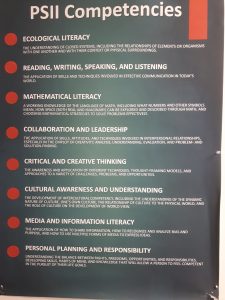This week in EdTech we had the opportunity to tour the Pacific Institute of Innovation and Inquiry (PSII), an independent high school that opened in Victoria several years ago and is gaining popularity in the area for its ‘progressive’ approach to education. Being in the school, surrounded by its ~95 learners and seven full-time staff members, reminded me of the Montessori elementary school where I spent the first four years of my education. This nostalgia reminded me that, far from being new, the pedagogical concepts that PSII embraces have been around for many years, and working successfully in elementary programs.
Education research has been aware for decades that teens learn better when they are actively engaged in their learning, and when they can relate their learning to their daily lives and interests. The Montessori model, and schools like it, have proven this to be effective, but only seem able to convince parents that this is appropriate for lower grades. Once kids hit high school, the expectation from students and parents is a switch to the ages-old system of one-room-one-subject designation, specialized teachers, and assessment by exams. This is thought to be the introduction to the ‘real world’, the factory model which would produce workers. As mentioned in the film Most Likely to Succeed, which follows a similar independent school in San Diego, CA, the ‘real world’ no longer works that way, and the skills that students need to succeed are perhaps better reflected at a school like PSII or High Tech High.

A poster on the wall at PSII detailing the competencies that should be achieved through inquiry-based learning. Note the lack of extensive lists of subject-specific PLOs. Image used with permission.
Part of the issue might be that the factory methods are thought of as preparation for university, which is also designed this way. While many aspects of university education have begun to change to a more active learning model, there is by design and necessity still a division of teachers and classrooms between and among subjects. The principal and founder of PSII, Jeff Hopkins (see below for one of his TEDx Talks on the school), stated with confidence that his students are doing well in university with the time management and decision-making skills they mastered at PSII. While I believe him, I would also like to hear more about these successes, and what kinds of changes students experience and struggle the most with going into various post-secondary programs.
For me, the aspect of deja vu aside, I feel the PSII model is intuitive and easy to get invested in. However, I can see the massive challenges in the way, including (as Hopkins pointed out) the basic structural layout of most high schools and the sheer volume of students. He strongly suggested that any more than 90 students would be too many to support effectively, given his small staff, and that larger schools should consider creating learning ‘pods’ to break up the number of students. I am interested to see how PSII continues to thrive, and how other schools and educators can find ways to emulate this learning style without having to wait for large-scale overhauls to the structure of public high schools.

Leave a Reply